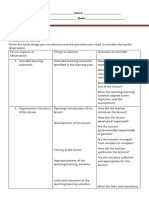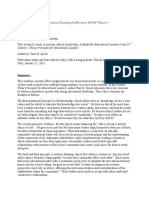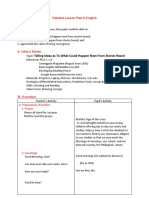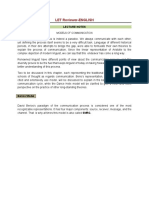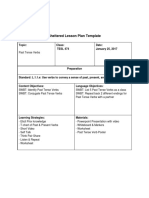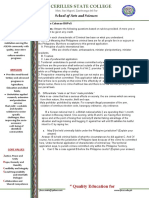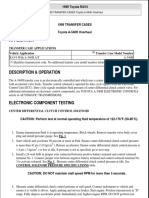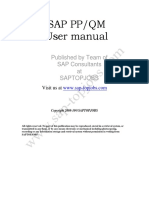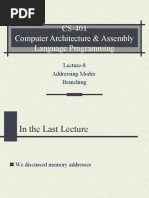0 ratings0% found this document useful (0 votes)
203 viewsDirections: Design A Graphic Organizer Featuring The Different Inventions
This document provides directions to design a graphic organizer to showcase inventions and discoveries from ancient, medieval, and modern times. It includes a sample graphic organizer format and provides a brief list of inventions and discoveries from Sumerians, Babylonians, Egyptians, Greeks, and others as examples to include in the designed graphic organizer.
Uploaded by
Noe Carillo CabusaoCopyright
© © All Rights Reserved
We take content rights seriously. If you suspect this is your content, claim it here.
Available Formats
Download as DOCX, PDF, TXT or read online on Scribd
0 ratings0% found this document useful (0 votes)
203 viewsDirections: Design A Graphic Organizer Featuring The Different Inventions
This document provides directions to design a graphic organizer to showcase inventions and discoveries from ancient, medieval, and modern times. It includes a sample graphic organizer format and provides a brief list of inventions and discoveries from Sumerians, Babylonians, Egyptians, Greeks, and others as examples to include in the designed graphic organizer.
Uploaded by
Noe Carillo CabusaoCopyright
© © All Rights Reserved
We take content rights seriously. If you suspect this is your content, claim it here.
Available Formats
Download as DOCX, PDF, TXT or read online on Scribd
You are on page 1/ 3
Activity 2.
Design ME
Directions: Design a graphic organizer featuring the different inventions/
discoveries during ancient, medieval , and modern times. Write a brief
description of each invention. A sample of graphic organizer design is given
below as your guide.
ANCIENT TIMES
The Chariot - the first two-wheeled chariot in which a driver drove a
SUMERIANS team of animals.
The Plow - a vital technology in farming.
Mathematics - Their system helped lay the groundwork for the
mathematical calculations of civilizations that followed.
Hydraulic Engineering - the sumerians civilization was the first
develop their agriculture. Who designed complex systems of canals, with
dams constructed of reeds, palm trunks and mud whose gates could be
The First
opened Mapto- regulate
or closed The Babylonian
the flow ofMap of the World is circular and
water.
depicts mountains, rivers, canals, and swamps. The seven small circles
Writing
on the map - the Sumerians
represent were the
the seven first to develop
Babylonian cities. a writing system. Either
way, it’s clear that they were using written communication
Cuneiform-is the first-known form of written communication by 2800- B.C.
is the
first-known form of written communication. It is a language as it
Language And Writing-Many Sumerian clay tablets written in
comprised script
cuneiform less than
have1,000
beencharacters,
discovered.and Theythese
are characters wereexample
not the oldest used forof
accounting,
writing, administrative
but nevertheless and business
represent a greatpurposes.
advance in the human ability to
Agriculture-
write down historyis a and
corecreate
practice in farmer sector and this invention of
literature.
the stone plow to set the ground. The Babylonians regulated the flow of
Religion-Sumerians
water to irrigate theirbelieved
crops and in dug
anthropomorphic polytheism,
canals and irrigation or of
ditches many
which,
gods in human form, which were specific to each city-state.
along with the plow, led the way for a new era of agricultural revolution.
Urbanization-the Babylonians gradually moved from rural areas to
Technology-Sumerians invented or improved a wide range of
more developed
technology, regions.
including the Babylonia as people
wheel, cuneiform moved
script, to citiesgeometry,
arithmetic, to seek
educational and employment opportunities.
irrigation, saws and other tools, sandals, chariots, harpoons, and beer.
BABYLONIANS
Astrology and Horoscopy- introduced by the Babylonians as they
believed in the divinity of the celestial bodies.
The Concept of Time-the Babylonians, who devised a system of
dividing time into 60 sections. Babylonians estimated that the earth
moved around the sun one degree in a day and took 360 days.
The Sailboat- water transportation during their times.
The First Wheel-their Land Transportation.
The Chariot-carts were used for the transportation of goods and for
traveling.
The Study of Mathematics-Babylonians developed many advanced
mathematical theories which are still in use today.
Art and Architecture-The Babylonians were prolific artists, and even
the most mundane household objects were beautifully decorated with
images of human or animal forms.
Medicines-treated physical and mental illnesses as the work of the gods
EGPTIANS and attempted to treat them using religious and magic remedies
performed by priests or even exorcists.
The Lock-represents a significant shift in the history of engineering.
The Police-to patrol and regulate the ships and boats traveling on the
Nile, to protect them from thieves and ensure that trade and the economy
continued to prosper.
Toothpaste And Breath Mints-toothpaste became one of the most
prominent
The Water Egyptian
Mill-meansinventions to prevent
to grind, and thatthem for those
invariably means whoto could
grind
afford it.
GREEKS grain.
The Odometer-measures
Tables-an explosion in the the art
distance traveled byas intricately
of furniture, a vehicle such as a
carved
bicycle or automobile.
items began to be created in Egypt.
The Alarm
Roman Clock-to possess
Numerals-Roman a large began
numerals water clock
to be with an unspecified
replaced by Arabic
The
alarm Calendar
signal And
similar to Timekeeping-the
the sound of a water Egyptian
organ. calendar was divided
numerals,
into twelvewhich
months benefitted
of 30 days from thealong
each, use ofwith
the five
zero,additional
making them
days much
at the
Cartography-is
more useful for the study
arithmetic andand practice
counting. of making maps. It has played
end of the year to bring the total up to 365.
an important
An Early form role of
in travel and navigation since
Newspaper-inscribed news ancient times.affairs unto
of current
Olympics-They
Barbers-men
stones, papyri, or were dedicated
employed
metal to cut
slabs, which to were
and thegroom
Olympian
placed gods and
thein hair
publicand were staged
beard
spaces. using
sharpened
on the plains
Modern flints and shells.
of Olympia.
Plumbing and Sanitary Management-Romans were very
Basis of Geometry-is
knowledgeable when it came doubtless
to civiloneengineering.their
of the oldest branches
engineering of
Make-Up
mathematics. And Wigs-Cosmetics and beauty regimes were also Egyptian
excellence is highlighted by their sewage and sanitary plumbing systems.
inventions.
Using
EarliestArches
Practice toof Build Structures-The
Medicine-it arch of
came to the curing directs pressure
disease.
downwards
Modern
Paper and outwards, creating
AndPhilosophy-as
Ink-papyrus, aofstrong
a way after
named passagereeds
understanding
the grassy underneath
thethat
world itaround
grew which
along
has
the the
Nile,ability
from to support
which the heavy
materialstructures.
was made.
them, without resorting to religion, myth, or magic.
The Hypocaust
Concept System-was a heating
of Democracy-The idea ofmechanism
every citizensomewhat
havingsimilar
equal
to modern-day central heating, or radiant floor
opportunity and a say in government constitutes the concept ofheating.
Aqueducts-Romans
democracy. built aqueducts to bring fresh water in from
neighboring
Discoveries sources into their
in Modern growing cities
Science-The and towns.
Greeks had so much influence
The First Surgical Tools- precision medical instruments
in the early concepts of science that most symbols used in physics and
ROMANS Developing
math equations Concrete
are derived tofrom
Strengthen Roman Buildings-Using a
the Greek alphabet.
mixture of volcanic ash, lime, and seawater, they developed a mix that
they used to add structural integrity to their buildings.
Roads That Can Withstand Time- Romans used a combination of
dirt and gravel with bricks made from hardened volcanic lava or granite,
making the roads immensely strong no matter the weather.
The Codex- The First Bound Book
The Electric Dynamo – 1831
The invention of the electric dynamo by Michael Faraday opened up the
practical use of electricity – from transport to power tools and home
appliances.
Computer – 1860s – Charles Babbage’s analytic engine is often seen as
the forerunner of the modern computer. It had the ability to be programmed
and calculate mathematical equations From these early experimental
machines, we saw the development of later electronic versions. Although the
electronic computer wasn’t really developed until after the 1940s.
Pasteurisation – 1864 Developed by Louis Pasteur. This provided a way
to prevent the growth of bacteria in substances such as wine, beer and milk.
It made milk safer to drink.
Chinese
Paper-China was the first nation to invent paper.
Plastic – 1869 Developed
Printing-Printed by John AWesley
in Tang Dynasty BuddhistHyatt.
sutraHyatt
is thewasfirstanbook
American
in the
printer
world and
withinventor.
a verifiable Hedatewasoflooking
printing. for a cheap substitute to ivory billiard
balls. Hyatt combined
Gunpowder -Creditcellulose
for the nitrate
invention andofcamphor
gunpowder to produce
also goes a mouldable
to ancient
versatile
China. material – celluloid.
Telephone
the Compass – 1876 The
Sinan- the telephone was tool
earliest guide invented
in the in 1876 by Alexander
world.The compass, an
indispensable
Graham navigational
Bell. Scottish borntool,
Bell waswasanother
a teacher significant
for thegift deaffromat ancient
Boston
China.
University. In researching ways to teach the deaf, he experimented with
transmitting sound via electricity.
Phonograph – 1877 Thomas Edison found that sound could be captured
and replayed using a rotating cylinder covered with paraffin paper and a
stylus.
Medieval Mechanical
Lightbulb – 1879 Throughout
Clock-the Middlethe nineteenth
Ages that the century,
technology inventors produced
was invented that
Times allowed for mechanical clocks to accurately keep track of time.
simple electric lights. For example, Joseph Swan produced a simple electric
Printing
light, but, he Press-printing technology ahad
struggled to maintain been source
power developedandin the
11thfilament
century China,
soon
it was the 15th century German
burned out when the vacuum was exhausted. Johannes Gutenberg and his printing press that
started a new era of the mass production of books.
Bicycle 1885 – Velocipedes were invented early in the nineteenth century.
Gunpowder-Gunpowder was invented in China sometime between the 9th and
The most popular at the time was the Penny Farthing, with its huge big
11th centuries, and it did not take long it to be used in weapons.
wheel.
Water But,and theWind bigMills-which
advancement allowedinpeople
biketo technology came from
harness the energy with the
natural
introduction
forces likeof rivers
a chain andtowind,
linkapedals
process tothat
back wheel. to the present-day.
continues
Aluminium 1886 Until kind
Coffee House-These the 1890s, Aluminium
of establishments wouldwasspread
considered a precious
into Europe during
metal thebecause it was so hard to isolate. However, Ohio chemist,
early modern era, changing not only how people ate and drank, but creating Charles
new
Martin Hall ways of social interaction.
discovered how to isolate Aluminium, through a process of
Eyeglasses-Its
electrolysis. ability to correct vision problems makes it a much it one of the
Motor most
Car useful medieval 1898
– 1898 By inventions.
the German engineer Karl Benz produced the
Public Library-The Library of Malatesta Novello in Cesena, Italy is considered
first modern automobile using a patented internal combustion engine. The
to be first ever public library in the world.
car used electrical ignition, a water-cooled internal combustion engine and
Flying Buttress-the flying buttress allowed buildings to have much higher
different gears.
ceilings, thinner walls and larger windows.
Pneumatic Tyre – 1888 Invented
Paper money-the common way currency by John Boyd Dunlop; it was developed
is issued.
Modern Times asa way to make tricycle riding moreable comfortable.
Quadrant and Astrolabe-Being to measure the distance between two
Camera – 1888 – Louis Daguerre made
objects, they proved to be useful instruments a breakthrough
in astronomy,with a camera
navigation and
whichsurveying.
took imprints to be developed by chemicals.Transatlantic
Telegram 1901 G. Marconi developed the first long-distance wireless
communication. On 12 December 1901, the first telegram was sent across
the Atlantic in Morse code.
X-Ray Machines (1914) The X-Ray was first discovered by W. Roentgen
in 1895. Marie Curie developed this discovery and through her work by 1914
and been able to successfully create an X-ray machine which could be used
to take images of the human skeleton.
You might also like
- Handbook of Research Methods and Applications in Political ScienceNo ratings yetHandbook of Research Methods and Applications in Political Science565 pages
- Techniques To Improve Grade 6 Molave Pupils' Difficulties in Remembering Significant Dates and Places in Philippine HistoryNo ratings yetTechniques To Improve Grade 6 Molave Pupils' Difficulties in Remembering Significant Dates and Places in Philippine History5 pages
- What's Up? What's Up?: Practice Teaching Learning EpisodeNo ratings yetWhat's Up? What's Up?: Practice Teaching Learning Episode8 pages
- Primitive and Sumerian Education: Prepared By: Lyreen Jolly V. GonzalesNo ratings yetPrimitive and Sumerian Education: Prepared By: Lyreen Jolly V. Gonzales22 pages
- Galicia, Clarece Liegh C. (Inference and Restatement)No ratings yetGalicia, Clarece Liegh C. (Inference and Restatement)4 pages
- A Matrix On Developing A Lesson in Reading: En4V-Iiif-38No ratings yetA Matrix On Developing A Lesson in Reading: En4V-Iiif-385 pages
- Experiencing The Teaching-Learning Process: Episode 3: Assisting A Teacher With A "Teacher's Toolbox"No ratings yetExperiencing The Teaching-Learning Process: Episode 3: Assisting A Teacher With A "Teacher's Toolbox"5 pages
- 2 Periodical Test: North Davao Colleges English 7No ratings yet2 Periodical Test: North Davao Colleges English 73 pages
- Jhea Velasco 2 Year BEED: Children Right LawNo ratings yetJhea Velasco 2 Year BEED: Children Right Law1 page
- Video-Stories: Effect To The Beginning Reading Skills of Kindergarten PupilsNo ratings yetVideo-Stories: Effect To The Beginning Reading Skills of Kindergarten Pupils12 pages
- Learner's Answer Sheets: For Modular Distance Learning Quarter 3-Week 7No ratings yetLearner's Answer Sheets: For Modular Distance Learning Quarter 3-Week 724 pages
- A Lesson Plan in 7 Grade English: I. Learning ObjectivesNo ratings yetA Lesson Plan in 7 Grade English: I. Learning Objectives3 pages
- HELE 6 LESSON PLAN - Using Wikis in The ClassroomNo ratings yetHELE 6 LESSON PLAN - Using Wikis in The Classroom5 pages
- GE 6 - SCIENCE, TECHNOLOGY, AND SOCIETY (MIDTERMS REVIEWER)No ratings yetGE 6 - SCIENCE, TECHNOLOGY, AND SOCIETY (MIDTERMS REVIEWER)8 pages
- Lesson 4-Phil. Political Thought Noe Cabusao AB-PolSciNo ratings yetLesson 4-Phil. Political Thought Noe Cabusao AB-PolSci2 pages
- Lesson 5 - Political Thought Noe Cabusao AB-Political Science LLNo ratings yetLesson 5 - Political Thought Noe Cabusao AB-Political Science LL2 pages
- Lesson 4-Intro. Philippine Politics and Governance Noe Carillo CabusaoNo ratings yetLesson 4-Intro. Philippine Politics and Governance Noe Carillo Cabusao2 pages
- Lesson 1-Intro. Politics and Governance - Noe Cabusao AB-POLITICAL SCIENCE LLNo ratings yetLesson 1-Intro. Politics and Governance - Noe Cabusao AB-POLITICAL SCIENCE LL2 pages
- Lesson 8 Philippine Politics and Governance Noe Cabusao AB-Political Science LLNo ratings yetLesson 8 Philippine Politics and Governance Noe Cabusao AB-Political Science LL1 page
- Lesson 7-Intro. Phil. Politics and Governance Noe Cabusao AB-Political Science LLNo ratings yetLesson 7-Intro. Phil. Politics and Governance Noe Cabusao AB-Political Science LL1 page
- Directions: Search For One Great Achievement/invention in Any of The GivenNo ratings yetDirections: Search For One Great Achievement/invention in Any of The Given1 page
- J.H. Cerilles State College: School of Arts and SciencesNo ratings yetJ.H. Cerilles State College: School of Arts and Sciences2 pages
- Creating New Foods The Product Developer'S Guide: Product Strategy Development: Idea Generation and ScreeningNo ratings yetCreating New Foods The Product Developer'S Guide: Product Strategy Development: Idea Generation and Screening4 pages
- Structural Fire Design According To EurocodesNo ratings yetStructural Fire Design According To Eurocodes56 pages
- Gym Equipment Energy Conversion Project (2008)No ratings yetGym Equipment Energy Conversion Project (2008)37 pages
- Theoretical Accuracy of Radar Measurements-Xd3No ratings yetTheoretical Accuracy of Radar Measurements-Xd37 pages
- CS-401 Computer Architecture & Assembly Language ProgrammingNo ratings yetCS-401 Computer Architecture & Assembly Language Programming27 pages
- Adi Masina Spalat Electrolux Ewm 3000 en Top Tutorial PDFNo ratings yetAdi Masina Spalat Electrolux Ewm 3000 en Top Tutorial PDF59 pages



